Khwaja Khidir and the Fountain of Life in the Tradition of Persian and Mughal Art
From Ananda K. Coomaraswamy, “What is Civilisation” and Other Essays, (Cambridge: Golgosova Press, 1989) pp. 157-167.
In India, the Prophet, Saint, or Deity known as Khwaja Khizr (Khadir), Pir Badar, or Raja Kidar, is the object of a still surviving popular cult, common to Muslims and Hindus. His principal shrine is on the Indus near Bakhar, where he is worshipped by devotees of both persuasions.
In western Asia, Moslem or Hindu symbolic art shows the Saint, Al Khizr, dressed in a green coat being carried on top of the water by a fish which conveys him over the river of life.
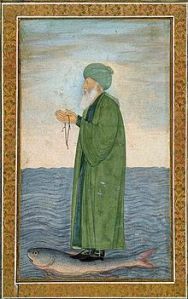 The cult is however hardly less widely diffused in Bihar and Bengal. In the Hindu cult, the Khwaja is worshipped with lights and by feeding Brahmans at a well, and alike in Hindu and Muslim practice, by setting a float in a pond or river a little boat which bears a lighted lamp. Iconographically Khwaja Khizr is represented as an aged man, having the aspect of a faqir, clothed entirely in green[1] and moving in the waters with a ‘fish’ as his vehicle.
The cult is however hardly less widely diffused in Bihar and Bengal. In the Hindu cult, the Khwaja is worshipped with lights and by feeding Brahmans at a well, and alike in Hindu and Muslim practice, by setting a float in a pond or river a little boat which bears a lighted lamp. Iconographically Khwaja Khizr is represented as an aged man, having the aspect of a faqir, clothed entirely in green[1] and moving in the waters with a ‘fish’ as his vehicle.
The nature of Khwaja Khizr can be inferred from his iconography as outlined above, and also from the Indian legends.
In the ballad of Niwal Dai, which is localized at Safidam[2] in the Panjab, Niwal Dai is the daughter of Vasuki, the chief of the Serpents. The Aryan Pandava Raja Pariksit has encountered Vasuki, and forced him to promise his daughter to him in marriage, though from Vasuki’s point of view this is a disgraceful misalliance. Vasuki is then stricken with leprosy, owing to a curse pronounced by the Priest Siji[3] whose cows have been bitten by the Serpents. Niwal Dai undertakes to obtain for his healing the Water of Life (amrta), from the closed well which she alone can open, but which is in the domains of Raja Pariksit.[4]
When she reaches the well, which is covered over by heavy stones, she moves these by her magic power, but the waters sink down out of reach; this is because Khwaja Khizr, their master, will not release them until Niwal Dai, whom none but her own parents Vasuki and his queen Padma have ever yet seen, permits herself to be seen; when Niwal Dai showed herself, then Khwaja Khizr ‘sent the waters up bubbling’. Raja Pariksit, aroused by the sound, gallops to the well, and though Niwal Dai hides in her serpent form, forces her to put on her human aspect, and after a long argument at the well, convinces her that she is bound by the previous betrothal, and in due course marries her.[5]
The scene at the well may also have been the original theme of the composition represented in a number of seventeenth and eighteenth century Mughal paintings, where a prince on horseback is shown at a well, from which a lady has drawn up water.[6]
The motif of a dynasty originating in the marriage of a human King with a Nagini is widely diffused in India, and in the last analysis can always be referred back to the rape of Vac, the Apsaras or Virgin of the Waters whose origin is with the powers of darkness and whom the Father-Creator has not ‘seen’ before the transformation of darkness into light, in principle; in this connection it is noteworthy that in the ballad, Niwal Dai has never seen the Sun or Moon, and has been kept hidden in a whirlpool (bhaithri) until she comes forth to uncover the Well at the World’s End, in which are the Waters of Life.[7] That she assumes a human form is her ‘manifestation’. It will be realised, of course, that just as in the European parallels, where a mermaid, or the daughter of a magician, marries a human hero, so in the later Indian folk tales and romances the redactor may not have always fully ‘understood his material’.
The Shrine of Khawaja Khizr, near Bukkur fort, 1838
Identified by Jackson as a view of ‘Hajee Ka Tau, an island just above the fort of Bukkur on the Indus’, the sketch would appear to be of the tomb of the river saint Khwaja Khizr, regarded as having been built in 925 A.D. (A.H. 341). According to the legend recorded in the Shachnama, the tomb was built in gratitude by a Delhi merchant Shah Husain who, traveling down the Indus with his pretty daughter on their way to Mecca, was called upon by Dalurai (the Hindu ruler of Alor) to surrender the daughter. In her anxiety to avoid such an impious alliance, the girl prayed to Khwaja Khizr for deliverance and as she and her father sought to escape in a boat, the saint diverted the course of the Indus towards Rohri bringing the harassed father and daughter to safety. Khwaja Khizr, known also as the Jinda or living Pir, is said to be particularly protective of travelers.
Look also: Khwaja Khizr: The saint who ‘saved’ Rohri, Sukkur and Lansdowne Bridge during the 1965 War
The main sanctum is bordered by small walls and adorned with colourful paper streamers. There is a raised platform in the middle, which is believed to be Khwaja Khizr’s takiya or gaddi (throne or seat), and is embellished with large alams (flags or signs), which are a testament to Shia influence nowadays.
Khwaja Khizr appears again in another Indian folk tale of a very archaic type, the Story of Prince Mahbub (note: The story of Prince Mahbub is essentially the relation of an achievement of the Grail Quest by a solar hero, the son of a widowed mother, and brought up in seclusion and innocence of his true character, as in the Perceval cycle. Mahbub corresponds to Vedic Agni and Surya; Kassab to Indra).
The king of Persia has a son by a concubine, who, in the absence of any other child, becomes the heir apparent. Subsequently the true queen becomes pregnant. The first prince fears that he will be displaced, invades the kingdom, slays his father, and usurps the throne.
In the meantime the true queen escapes, and is cared for by a farmer; a son is born, who is called Mahbub, and the ‘Darling of the World’. Later he goes alone to court, and becomes the victor in athletic contests, particularly as an archer. The people recognise his likeness to the late king.
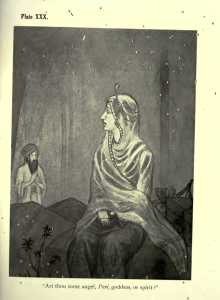 On his return home his mother tells him of his birth, and both set out on their travels in order to avoid the usurper’s suspicion. Mother and son reach a desert land, and there in a mosque beside a mountain they meet a faqir who gives them bread and water that are inexhaustible, and two pieces of wood, one of which can serve as a torch, the other possessing this virtue, that within a radius of fourteen cubits from the place where it is held, the deepest sea will become fordable, and no more than a cubit in depth.
On his return home his mother tells him of his birth, and both set out on their travels in order to avoid the usurper’s suspicion. Mother and son reach a desert land, and there in a mosque beside a mountain they meet a faqir who gives them bread and water that are inexhaustible, and two pieces of wood, one of which can serve as a torch, the other possessing this virtue, that within a radius of fourteen cubits from the place where it is held, the deepest sea will become fordable, and no more than a cubit in depth.
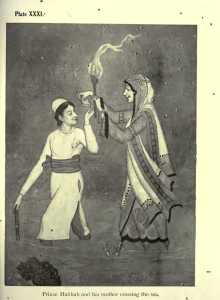 As mother and son are then wading through the sea knee-deep, they meet with a ruby-bearing current.
As mother and son are then wading through the sea knee-deep, they meet with a ruby-bearing current.
They cross the sea and reach India, where they sell one of the rubies at a great price. It comes into the hands of the king of that country. He finds out its source, and seeks the hero, who has in the meantime built a new and great palace by the seaside. Mahbub undertakes to procure more of the same kind. He sets out alone, lights the torch (this shows that he is about to enter a world of darkness), and aided by the rod traverses the sea till he reaches the ruby current. He follows it up until he finds its source in a whirlpool. He jumps in and falls down the black watery chimney until he touches solid ground and finds the waters flowing out from an iron gateway of a conduit.
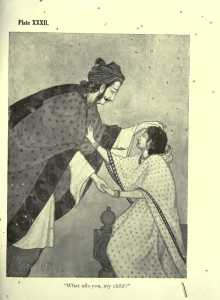 Passing through this he finds himself in a wonderful garden, in which is a palace. In this palace he finds a room in which is a freshly severed head, from which drops of blood are falling into a basin, and are carried out as rubies with the current into the conduit and so to the whirlpool and up into the sea.
Passing through this he finds himself in a wonderful garden, in which is a palace. In this palace he finds a room in which is a freshly severed head, from which drops of blood are falling into a basin, and are carried out as rubies with the current into the conduit and so to the whirlpool and up into the sea.
Twelve paris (Apsarases; Grail maidens) then appear, take down the head, bring forth the trunk, lay the parts together, and taking up burning candles execute a dance round the couch, so swift that Mahbub can see only a circle of light. Then stooping over the bed, they wail ‘How long, O Lord, how long? . . . When will the sun of hope arise on the darkness of our despair? Arise, O King, arise, how long will you remain in this deathlike trance?’ ( The ‘wailing women’ and ‘deathlike trance’ of the Fisher King are essential features of the Grail myth).
 Then from the floor of the palace there rises up the form of the faqir previously mentioned, and now clad in garments of light. The pans bow down to him, and ask ‘Khwaja Khizr, has the hour come?’ The faqir, who is indeed none but the immortal Khwaja Khizr, explains to Mahbub that the corpse is his father’s, who had been murdered by the usurper Kassab; Mahbub’s ancestors have all been magi;[11] all have been buried in the under-water palace, but Mahbub’s father has remained unburied, for none had performed his funeral rites;
Then from the floor of the palace there rises up the form of the faqir previously mentioned, and now clad in garments of light. The pans bow down to him, and ask ‘Khwaja Khizr, has the hour come?’ The faqir, who is indeed none but the immortal Khwaja Khizr, explains to Mahbub that the corpse is his father’s, who had been murdered by the usurper Kassab; Mahbub’s ancestors have all been magi;[11] all have been buried in the under-water palace, but Mahbub’s father has remained unburied, for none had performed his funeral rites;
Mahbub, as son, should now do this- Mahbub accordingly makes prayer to Allah on behalf of his father’s soul.
 Immediately the head is joined to the body, and the dead king rises up alive.[12] Khizr vanishes, and Mahbub returns to India with his father, who is thus reunited with the widowed queen. When the king of India comes for the rubies, Mahbub pricks his own finger, and the drops of blood falling into a cup of water become the required gems, for as Mahbub now knows, every drop of blood that flows in the veins of the kings of Persia is more precious than rubies.
Immediately the head is joined to the body, and the dead king rises up alive.[12] Khizr vanishes, and Mahbub returns to India with his father, who is thus reunited with the widowed queen. When the king of India comes for the rubies, Mahbub pricks his own finger, and the drops of blood falling into a cup of water become the required gems, for as Mahbub now knows, every drop of blood that flows in the veins of the kings of Persia is more precious than rubies.
Mahbub marries the princess of India. An expedition to Persia dethrones the usurper Kassab, and his head is taken and hung in the underground palace, but every drop of blood becomes a toad.
The true nature of Khwaja Khizr is already clearly indicated in the two stories summarised above, as well as in the iconography. Khizr is at home in both worlds, the dark and the light, but above all master of the flowing River of Life in the Land of Darkness: he is at once the guardian and genius of vegetation and of the Water of Life, and corresponds to Soma and Gandharva in Vedic mythology, and in many respects to Varuria himself, though it is evident that he cannot, either from the Islamic or from the later Hindu point of view be openly identified with the supreme deity. We shall find these general conclusions amply confirmed by further examinations of the sources of the Islamic legends of al-Khadir.
In the Qur’an (Sura XVIII, 59-81) occurs the legend of Musa’s search for the Ma’jma ‘al-Bahrain,[13] which is probably to be understood as a ‘place’ in the far west at the meeting of two oceans;
Musa is guided by a ‘servant of God’, whom the commentators identify with al-Khadir, whose abode is said to be upon an island or on a green carpet in the midst of the sea?
This story can be traced back to three older sources, the Gilgamesh epic, the Alexander Romances, and the Jewish legend of Elijah and Rabbi Joshua ben Levi.[14]
 In the Gilgamesh epic the hero sets out in search of his immortal ‘ancestor’ Utnapishtim who dwells at the mouth of the rivers (ina pi narati), like Varuna whose abode is ‘at the rivers’ source’, sindhunam upodaye. Rg Veda, VIII, 41, 2; his object being to be informed with respect to the ‘plant-life’, prototype of the Avestan haoma, Vedic soma,[15] whereby man can be saved from death.
In the Gilgamesh epic the hero sets out in search of his immortal ‘ancestor’ Utnapishtim who dwells at the mouth of the rivers (ina pi narati), like Varuna whose abode is ‘at the rivers’ source’, sindhunam upodaye. Rg Veda, VIII, 41, 2; his object being to be informed with respect to the ‘plant-life’, prototype of the Avestan haoma, Vedic soma,[15] whereby man can be saved from death.
 In the Alexander Romances Alexander sets out in search of the Fountain of Life, which is accidentally found, and significantly ‘in the land of darkness’, but cannot be found again. A recension of this legend occurs in the Shah Nama, where Alexander sets out in search of the Fountain of Life, which lies in the Land of Darkness beyond the place of the setting of the Sun in the western waters; Alexander is guided by Khizr, but when they come to a parting of the ways, each follows a different path, and Khizr alone accomplishes the quest. Those of Alexander’s followers who bring back with them stones from the Land of Darkness find on their return that these are precious stones.[16]
In the Alexander Romances Alexander sets out in search of the Fountain of Life, which is accidentally found, and significantly ‘in the land of darkness’, but cannot be found again. A recension of this legend occurs in the Shah Nama, where Alexander sets out in search of the Fountain of Life, which lies in the Land of Darkness beyond the place of the setting of the Sun in the western waters; Alexander is guided by Khizr, but when they come to a parting of the ways, each follows a different path, and Khizr alone accomplishes the quest. Those of Alexander’s followers who bring back with them stones from the Land of Darkness find on their return that these are precious stones.[16]
The story is retold at greater length in Nizami’s Iskandar Naama, LXVIII-LXIX; here Alexander learns from an ancient man (probably Khizr himself in human form) that ‘of every land, the Dark Land is best, in which is a Water, a life-giver’ and that the source of this River of Life is in the North, beneath the Pole Star.[17] On the way to the Dark land, in every arid land the rain falls and grass springs up, ‘Thou wouldst have said: “The trace of Khizr was on that road; that verily, Khizr himself was with the king”.[18] They reach the northern limit of the world, the sun ceases to rise, and the Land of Darkness lies before them.
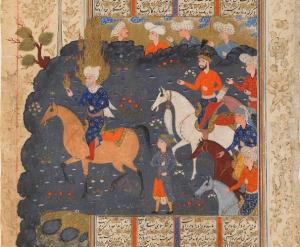 Alexander makes the prophet Khizr his guide, and Khizr ‘moving with greenness[19] leads the way, and presently discovers the fountain, from which he drinks, becoming immortal. He keeps his eye on the spring, while waiting for Alexander to catch up with him; but it disappears from sight, and Khizr himself vanishes, realising that Alexander will not succeed in his quest.
Alexander makes the prophet Khizr his guide, and Khizr ‘moving with greenness[19] leads the way, and presently discovers the fountain, from which he drinks, becoming immortal. He keeps his eye on the spring, while waiting for Alexander to catch up with him; but it disappears from sight, and Khizr himself vanishes, realising that Alexander will not succeed in his quest.
Folio from a Shahnama Book of kings by Firdawsi 1020 recto Iskandar encounters the Angel Israfel verso text Iskandar crosses the Land of Darkness removes the ruby Iskandar constructs a wall to defeat Gog and Magog
Nizami goes on to relate another version according to the ‘account of the elders of Rum’; here the quest is undertaken by Ilyas[20] and Khizr, who sit down by a fountain to eat their repast, consisting of dried fish; the fish falling into the waters, comes to life, and thus the seekers are made aware that they have found the Fountain of Life, from which both drink.
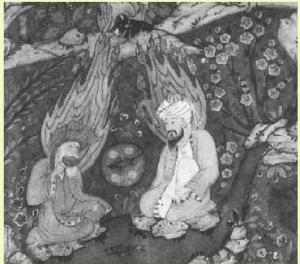 Khizr and Ilyas at the Fountain of Life. Amir Khusrau, Khamsah Ilyas and Khizr sit down by a fountain to eat their repast, consisting of dried fish; the fish falling into the waters, comes to life, and thus the seekers are made aware that they have found the Fountain of Life, from which both drink.
Khizr and Ilyas at the Fountain of Life. Amir Khusrau, Khamsah Ilyas and Khizr sit down by a fountain to eat their repast, consisting of dried fish; the fish falling into the waters, comes to life, and thus the seekers are made aware that they have found the Fountain of Life, from which both drink.
Nizami then proceeds to the Kur’anic version, and interprets the Fountain as one of Grace, the true Water of Life being the Knowledge of God. A similar interpretation of the ancient material occurs in the New Testament, (John, 4).
Note: John –4″: Now Jesus learned that the Pharisees had heard that he was gaining and baptizing more disciples than John— 2 although in fact it was not Jesus who baptized, but his disciples. 3 So he left Judea and went back once more to Galilee. 4 Now he had to go through Samaria. 5 So he came to a town in Samaria called Sychar, near the plot of ground Jacob had given to his son Joseph. 6 Jacob’s well was there, and Jesus, tired as he was from the journey, sat down by the well. It was about noon.7 When a Samaritan woman came to draw water, Jesus said to her, “Will you give me a drink?” 8 (His disciples had gone into the town to buy food.) 9 The Samaritan woman said to him, “You are a Jew and I am a Samaritan woman. How can you ask me for a drink?” (For Jews do not associate with Samaritans. 10 Jesus answered her, “If you knew the gift of God and who it is that asks you for a drink, you would have asked him and he would have given you living water.” 11 “Sir,” the woman said, “you have nothing to draw with and the well is deep. Where can you get this living water? 12 Are you greater than our father Jacob, who gave us the well and drank from it himself, as did also his sons and his livestock?” 13 Jesus answered, “Everyone who drinks this water will be thirsty again, 14 but whoever drinks the water I give them will never thirst. Indeed, the water I give them will become in them a spring of water welling up to eternal life.”
Nizami attributes Iskandar’s failure to his eagerness, whereas in the case of Khizr ‘the Water of Life arrived unsought’, with reference to the fact that it is revealed indirectly by its effect on the fish, when Khizr has no suspicion that he has already reached it.
The finding of the Fountain by Ilyas and Khizr occurs in Persian art as the subject of miniatures illustrating the Iskandar Nama.[21] One of these, from a late sixteenth century manuscript belonging to Mr A. Sakisian, is reproduced in colour as frontispiece to his La Miniature persane, 1929, and in monochrome by L. Binyon, Persian Painting, 1933, PI. LXIa; here the two prophets are seated by the Well in a verdant landscape, two fish are seen lying on a platter and a third, evidently alive, is in Khizr’s hand; it is clear that he is pointing out to Ilyas the significance of the miracle. Ilyas is robed in blue, Khizr wears a green robe with a brown cloak.
In another, and unpublished version of the seventeenth century, belonging to the Freer Gallery the arrangement is similar, but only one fish is seen on the platter. A third example, in the Museum of Fine Arts, Boston, and or late fifteenth century date, is reproduced in Ars Asiatica, XIII. PI. VII, no. 15; Ilyas and al-Khadir are seen in the foreground beside the stream, in darkness; Alexander and his followers above, as in the Freer Gallery example, where the arrangement of the darks and lights is reversed. The Freer Gallery example seems to be the more correct in this respect, inasmuch as the whole quest takes place within the Land of Darkness, but the immediate vicinity of the Fountain of Life is understood to be lighted up by the sheen of its flowing waters. The Finders of the Well are both nimbate.
In the Syrian Lay of Alexander, and in the Qur’anic version, the fish swims away, and in the latter is said to reach the sea. A connection with the story of Manu and the ‘fish’ may be predicated in the Manu myth (Satapatha Bramana, I.8.i); the ‘fish’ (jhasa) is from the beginning alive, but very small, and precariously situated, for it comes into Manu’s hands when he is washing, and asks him to rear it. Manu provides it with water, and after it has grown great, releases it in the sea; and when the Flood comes, it guides the Ark through the Waters by means of a rope attached to its horn.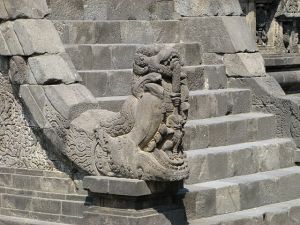
A noteworthy variant of the Manu legend, with a closer parallel to the Alexander and Qur’anic versions with respect to the dessication of the ‘fish’ occurs in Jaimimya Brahmana, in. 193, and Pancavimsa Brahmana, xiv. 5. 15; here Sarkara, the ‘sisumara’, refuses to praise Indra, Parjanya therefore strands him on dry land and dries him up with the north wind (the cause of the desiccation of the fish is thus indicated). Sarkara then finds a song of praise for Indra, Parjanya restores him to the ocean (as does Khizr, though unintentionally, in the Qur’anic version), and by the same laud Sarkara attains heaven, becoming a constellation.
There can be no doubt that the constellation Capricornus, Skr. makara, makarasi, is intended. Makara, jhasa, and sisumara are thus synonymous;[22] and this Indian Leviathan clearly corresponds to the kar-fish, ‘greatest of the creatures of Ahuramazda’, who swims in Vourukasha, guarding the Haoma tree of life in the primordial sea (Bundahis, XVIII; Yasna, XLII. 4, etc.); and to the Sumerian goat-fish, the symbol and sometimes the vehicle of Ea, god of the waters (Langdon, Semitic Mythology, pp.105-6).
That in the late Indian iconography Khizr’s vehicle is an unmistakable fish, and not the crocodilian makara, need not surprise us, for other instances of the alternative use of makara and ‘fish’ could be cited from Indian iconographic sources; in some early representations, for example, the river-goddess Ganga is shown supported by a maker, but in the later paintings by a fish.
In the Pseudo-Callisthenes (C) version of the Alexander legend, Alexander is accompanied by his cook, Andreas. After a long journey in the Land of Darkness, they come to a place gushing with waters, and sit down to eat; Andreas wets the dried fish, and seeing that it comes to life, drinks of the water, but does not inform Alexander. Subsequently Andreas seduces Alexander’s daughter Kale, and gives her a drink of the Water of Life (of which he had brought away a portion); she having thus become an immortal goddess is called Nereis, and the cook is flung into the sea, becoming a god; both are thus denizens of the other world. There can be no doubt that Andreas here is the Idris of Qur’an, Sura xix, 57ff. and Sura xxi, 85, whom Islamic tradition identifies with Enoch, Ilyas, and al-Khadir. From the account of Idris in Ibn al-Qifti’s Tarikh al-Hukama’a (c. 1200) it appears that he plays the part of a solar hero, and is immortal.
Al-Khadir also presents some point of resemblance with Saint George, and it is in this connection and as patron of travellers that we meet with a figure which is probably that of al-Khadir in carved relief over the gateway of a caravanserai on the road between Sinjar and Mosul, of the XI nth century; the figure is nimbate, and is thrusting a lance into the mouth of a scaly dragon.[23]
The figure of a man seated on a fish occurs apparently as a Hindu work built into the bastion of the fort at Raichur, in the Deccan; it is stated to have a ‘crown of river-serpent hoods’, and has therefore been called a ‘naga king’, but these hoods are not clearly recognisable in the published reproduction.[24] Mediaeval Indian art affords numerous examples of Varuna seated on a makara.
A brief reference may be made to European parallels similarly derivative in the last analysis from Sumerian sources. Khadir corresponds to the Greek sea-god Glaukos (Friedlander, loc. cit. pp. 108 ff., 242, 253, etc., Barnett, loc. cit. p.715). Khadir belongs to the Wandering Jew type.
Parallels between Glaukos and Vedic Gand-harva are noteworthy; the Avesran designation of Gandarva as zairipasna ‘green-heeled’ tends to a connection of Gandharva with Khadir. Gandharva, as suggested by Dr. Barnett, may correspond to Kandarpa, i.e. Kamadeva, and in this connection it may be observed that the erotic motif common to Glaukos and Gandharva-Kamadeva appears in connection with Khizr in the Niwal Dai ballad, where Khizr will not release the waters unless he has sight of Niwal Dai; as might be looked for if we think of him as the Gandharva, and of her as the apsaras or Maiden (yosa) of the Waters, or equally if we correlate Khizr with Varuna, cf. Rg Veda, VII. 33. 10-11 where Mitra-Varuna are seduced by the sight of Urvasi, as is emphasized in the Sarvanukramani, 1.166 urvasim apsarasam drstva . . . reto apatat, and Sayana, retas caskanda evidently following Nirukta, v. 13.
The same situation is implied in Rg Veda, VII. 87. 6 with respect to Varuna alone who descends as a white drop (drapsa) and is called a ‘traverser of space’ (rajasah vimanah) and ‘ruler of the deep’ (gambhira-sansah), epithets that might well be applied to Khizr.
It remains to be observed that in Christian iconography the figure of the river-god Jordan,[25] commonly found in representations of the Baptism of Jesus, bears a certain likeness to the conception of Glaukos and Khizr.
In some cases the Baptism was thought of as taking place at the junction of two rivers, Jor and Danus. Sometimes there is found a masculine river-god, and a feminine figure representing the sea; both riding on dolphins, like the numerous types of Indian dwarf Yaksas riding on makaras.
Note: the River Jor-Dan
- The wisdom Lal Shabaz Qalandar
The Shrine of Lal Shabaz Qalandar (Urdu: لال شہباز قلندر مزار; Sindhi: لال شهباز قلندر جي مزار) is a Sufi shrine dedicated to the 13th century Islamic mystic, Lal Shahbaz Qalandar. The shrine is located in Sehwan Sharif, in the Pakistani province of Sindh. The shrine is one of the most important in Pakistan,[1] and attracts up to one million visitors annually.
More Info Lal Shahbaz Qalandar
Syed Shah Hussain (1177 – 1274), popularly known as Lal Shahbaz Qalandar
Syed Shah Hussain[1] (1177 – 1274),[1] popularly known as Lal Shahbaz Qalandar (Sindhi: لعل شھباز قلندر), was a scholar, Sufi saint and religious-poet of present-day Pakistan and Afghanistan.[3][1] He is revered and respected by both Muslims and Hindus in the region since he preached religious tolerance between the faiths.[1][2] He was called Lal (“ruby-colored”) after his usual red attire and “Shahbaz” to denote a noble and divine spirit and “Qalandar” as he was a wandering holy man.[1] The spiritual song “Dama Dam Mast Qalandar“, based on an original version from the 13th century, glorifies the saint and his teachings and in recent decades hase been widely popular within the Indian subcontinent.
More info Syed Shah Hussain (1177 – 1274), popularly known as Lal Shahbaz Qalandar
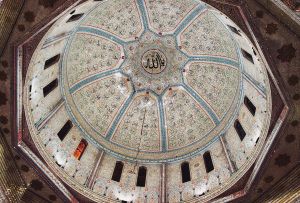 Look also Dama Dam Mast Qalandar
Look also Dama Dam Mast Qalandar
Translation of a spiritual Sufi song written in the honour of the most revered Sufi saint of Sindh, Lal Shahbaz Qalandar
 Jhulelal (Sindhi/Urdu: جھولےلال), refers to Lal Shahbaz Qalandar, a prominent Sufi Muslim saint who lived in the Middle East, Afghanistan, Sindh (Pakistan) and India in the thirteenth century.[1][2]
Jhulelal (Sindhi/Urdu: جھولےلال), refers to Lal Shahbaz Qalandar, a prominent Sufi Muslim saint who lived in the Middle East, Afghanistan, Sindh (Pakistan) and India in the thirteenth century.[1][2]
The term Jhulelal is actually the name of a Hindu deity Jhulelal, who is worshipped by the Sindhi Hindus.However the Sufi muslims started using the term Jhulelal only after the song Dama Dam Mast Qalandar became famous, in which Lal Shabaz Qalandar has been referred to as “Jhulelal Qalandar”.[3] His sufi name is Lal Shahbaz Qalandar and actual name is Usman Mrwandi.The reason for him to be called Lal is because Lal means red, as he usually wears a red attire and Shahbaz due to his divine and noble spirit and Qalandar for his affiliation to Sufi.[4]The term Jhulelal means “red bridegroom”.[3]
Read also The Qalandar in the Persianate World
All these types in the last analysis may be referred back to prototypes of which our earliest knowledge is Sumerian, in the concept or Ea, son and image of Enki, whose essential name Enki means ‘Lord of the Watery Deep’. Ea was the ruler of the streams that rose in the Underworld, and flowed thence to fertilize the land; precious stones are likewise his.
In iconography, Ea has the goat-fish, and holds in his hands the flowing-vase, the source of the ‘bread and water of immortal life’.
Ea has seven sons, of whom Marduk inherits his wisdom and slew the dragon Tiamat.
Another son was Dumuziabzu, the ‘Faithful Son of the Fresh Waters’, the Shepherd, the Semitic form of whose name is Tammuz, well known as the ‘Dying God’ of vegetation; comparable in many respects with Soma, and as ‘Lord of the Realm of the Dead’ with Yama.
The further Sumerian parallels are too many and too close to admit of adequate discussion here.[26] It suffices to have demonstrated the wide diffusion and ancient origin of the figure of Khwaja Khizr as it occurs in Persian and Indian iconography. In connection with Mughal art may be cited the remark of H. Goetz, who in discussing the sources of Mughal art speaks of a ‘teils absolute Identitaet teils engste Verwandschaft mit solchen der grossen altorientalischen Kulturen, und zwar zu gut Teilen schon der klassischen sumerischen Zeit’.[27] That the figure of Khizr comes into independent prominence precisely in Mughal art of the eighteenth century—all the Indian examples that I have seen are in the ‘Lucknow style’— when considered in connection with the adoption of the fish as royal emblem by the rulers of Oudh, seems to show that some revival of the cult took place at this time and in this area.
[1] In accordance with the meaning of al-Khadir, the ‘Green Man’.
[2] Safidam, probably a corruption of sarpa-damana, ‘Quelling of the Serpent’. For the legend of Niwal Dai see Temple, Legends of the Punjab, I, pp. 414, 418-19.
[3] Usually Sanja (perhaps for Skr. Samjna). This priest (Brahman) who serves Vasuki, but acts against him, suggests Visvarupa who in Taittinya Samhita, LI. 5. 1 is called the Purohita of the Angels, and Usanas Kavya who in Pancavimsa Brahmana, VII. 5. 20 is the Purohita of the Titans, but is won over to the side of the Angels.
[4] A location of the Well in the domains of the human Pariksit is hardly ‘correct’, (it is really on the borders of both worlds, in a forest equally accessible to Vasuki and Pariksit), but it will be observed that the waters are not merely protected by the heavy stone covering, but also subject to Khizr’s will, they- are not ‘flowing’. Vedic equivalents for the ‘heavy stone’ which hinders access to the waters are abundant, e.g. IV. 28. 5 aphitani asna, VI. 17. 5 adrim acyutam, IV. 16. 8 apah adrim, IV. i. 15 drdhram ubdham adrim, IV. 18.6 paridhim adrim, and when the stony obstacle is broke?, then “the waters flow from the pregnant rock”, srnvantnv apah . . . babrhanasya adreh, V. 41.12; cf. Satapatha Brahmana IX. 1.2.4 in connection with the baptism of the fire-altar, which begins ‘from the rock’, because it is from the rock that the waters come forth, asmano hy apahprabhavanti. Vasuki in the ballad corresponds to Ahi, smitten by Indra, but ‘still waxing in sunless gloom’, Rg Veda, v, 32. 6.
[5] In the theme condensed above it is easy to recognise the Vedic creation-myth of the conflict between Angels and Titans (Devas and Asuras), Indra and Ahi-Vrtra; the abduction of Niwal Dai is the rape of Vac, (Rg Veda, i. 130, where Indra vacam musayati); Khwaja Khizr, the master of the waters, the Vedic rivers of life, is Varuna.
[6] E. G. Blochet, Peintures hindoues de la Bibliotheque Nationale, Paris, 1926. Pls. V and XXIII.
[7] The world under water, the home of the serpent race (ahi, naga), Varuna’s ‘watery origin’ (yonim apyam, Rg Veda, II, 38, 8), ‘in the western gloom’ (apacinc tamasi, ib. VI, 6, 4), is not lighted by the Sun, it is ‘beyond the Falcon’ (Jaiminiya Brahmana, III, 268), but the shining of the Waters is everlasting (ahar-ahar yati aktur apam, Rg Veda, II. 30.1).
[8] Shaikh Chilli, Folk Tales of Hindustan, Allahabad, 1913, pp. 130 ff., with a modern picture of Khwaja Khizr as an old man blessing Mahbub, PI. XXXIII. The story of Prince Mahbub is essentially the relation of an achievement of the Grail Quest by a solar hero, the son of a widowed mother, and brought up in seclusion and innocence of his true character, as in the Perceval cycle. Mahbub corresponds to Vedic Agni and Surya; Kassab to Indra.
[9] Apsarases; Grail maidens.
[10] The ‘wailing women’ and ‘deathlike trance’ of the Fisher King are essential features of the Grail myth.
[11] Equivalent to Skr. mahin, ‘magician’, a designation especially applicable to the Titans and, secondarily to the premier Angels, particularly Agni, the ‘ancestors’ represent the solar heroes of former cycles.
[12] The Grail Quest is achieved.
[13] Bahrain, an island in the Persian Gulf, has been identified by many scholars with the Sumerian Dilmun, where dwelt the gardener Tagtut after the flood: see Delitzsch, Wo lag das Parodies, p.178, and Langdon, Sumerian Epic, pp. 8ff.
[14] For Islamic legend, other parallels, and further references see Encyclopedia of Islam, s. v. Idris, al-Khadir and Khwadja Khidr; Warner, Shah Nama of Firdausi, VI, pp. 74-8 and 159-162; Hopkins, ‘The Fountain of Youth’. JAOS. XXVI; Barnett, ‘Yama, Gandharva, and Claucus’, Bull. School Oriental Studies, IV; Grierson, Kihar Peasant Life, pp. 40-3; Garcin de Tassy, Memoire sur des Particularites de la Religion Musalmane dans l’Inde, pp. 85-9; Wunsche, Die Sagen voin Lebensbaum und Liebenswasser, Leipzig, 1905; Friedlander, Die Chadhirlegende und der Alexander-Roman, Leipzig, 1913.
[15] Cf. Barnet, loc. cit., pp. 708-10.
[16] Cf. Rg Veda, VII. 6. 4 and 7, where Agni is said to bring forth the Maidens (rivers of life) eastward from the ‘western darkness’ (apacine tamasi) and to bring back ‘treasures of earth’ (budhnya vasuni) ‘when the Sun rises’ (udita suryasya).
[17] Al-Khadir’s realm, known as Yuh (also a name of the Sun), where he rules over saints and angels, is situated in the far North; it is an Earthly Paradise, a part of the human world which
remained unaffected by the Fall of Adam and the curse (see Nicholson, Studies in Islamic Mysticism, pp. 82,124).
[18] According to ‘Umarah, Khizr is ‘Green’ because the earth becomes green at the touch of his feet.
[19] Khazra, either ‘verdure’ or ‘sky’.
[20] The prophet Elias, with whom Khizr is often identified.
[21] Cf. Iskandar Nama, LXIX. 57, ‘verdure grows more luxuriantly by the fountain’. Ibid. 22, (he spring is described as a ‘fountain of light’, and this corresponds to Vendidad, Fargad xxi, where light and water proceed from a common source; cf. also Vedic Soma as both light and life, a plant and a fluid (amrta, the Water of Life, cf. Barnett, loc. cit., p. 705, note 1).
[22] In Bhagavad Gita, X. 31, Krsna is jhasanam makarah, the makara is therefore regarded as the foremost amongst the jhasas, or monsters of the deep. The word makara occurs first in Vajasaneyi Samhita, XXIV. 35; simsumara in Rg Veda, I. 116. 18. For a full discussion of the makara in Indian iconography (especially as vehicle of Varuna and banner of Kamadeva) see my Yaksas, 1931,11, p. 47ff. and further references there cited. The ‘fish’ vehicle, of course, implies the rider’s independence of local motion in the unbounded ocean of universal possibility; just as wings denote angelic independence of local motion in the actual worlds.
[23] Sarre und Herzfeld, Archaeologische Reise im Euphrat-und Tigris-Gebiet, Vol. I, pp. 13, and 37-8, Berlin, 1911.
[24] See my Yaksas, 11.
[25] For example, in the Baptistry at Ravenna (Berchem and Clouzot, figs. lii and 220); Jordan here holds a vase from which the waters are flowing.
[26] For the Sumerian deities see S. H. Langdon, Semitic Mythology, Ch. 2; for the flowing vase etc. Van Buren, The Flowing Vase and the God with Streams, Berlin, 1933, and as regards India, my Yaksas, 11. For the iconographic link between me Asiatic full vase and Christian Grail vessel see Gosse, Recherches sur quelques representations du Vase Eucharistique, Geneva, 1894.
[27] Bilderatlas ziir Kulturgeschichte Indiens in der Grossmoghul-Zeit, 1930, p. 71. ‘An in part absolute identity and an in part very close Kinship with the sources of the great cultures of the ancient East and even to a considerable extent with the sources of the classical Sumerian period.’






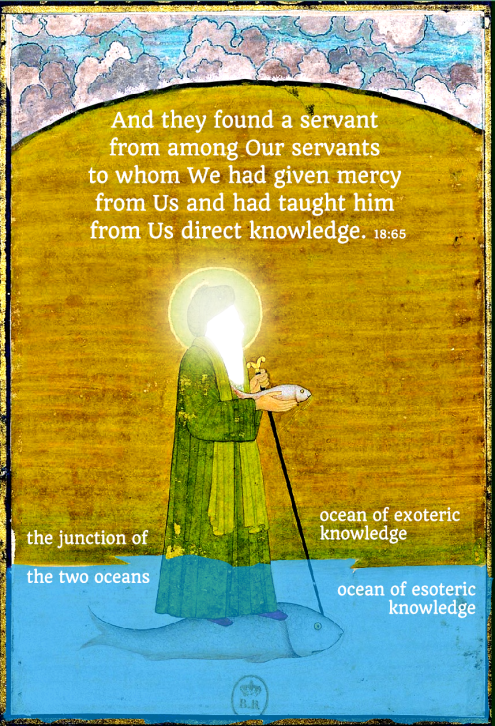
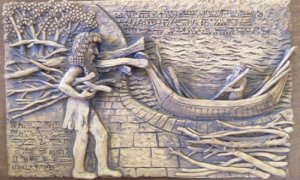

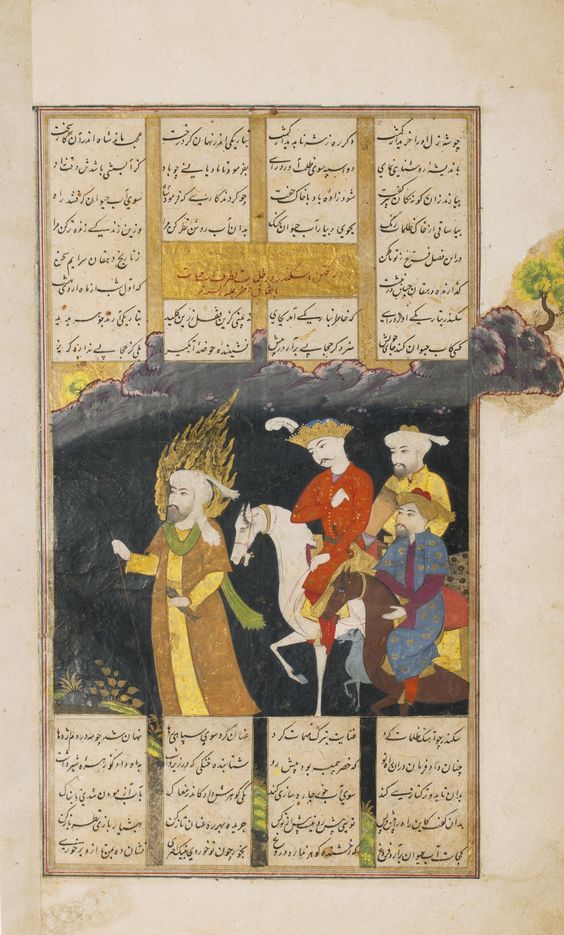

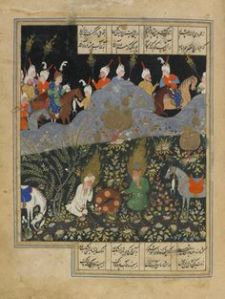




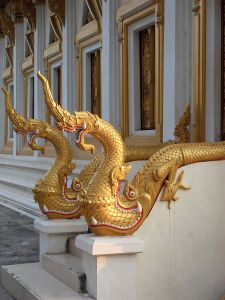




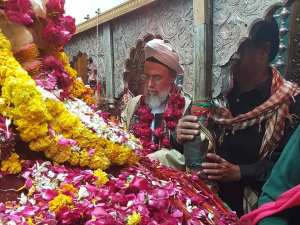

 see
see